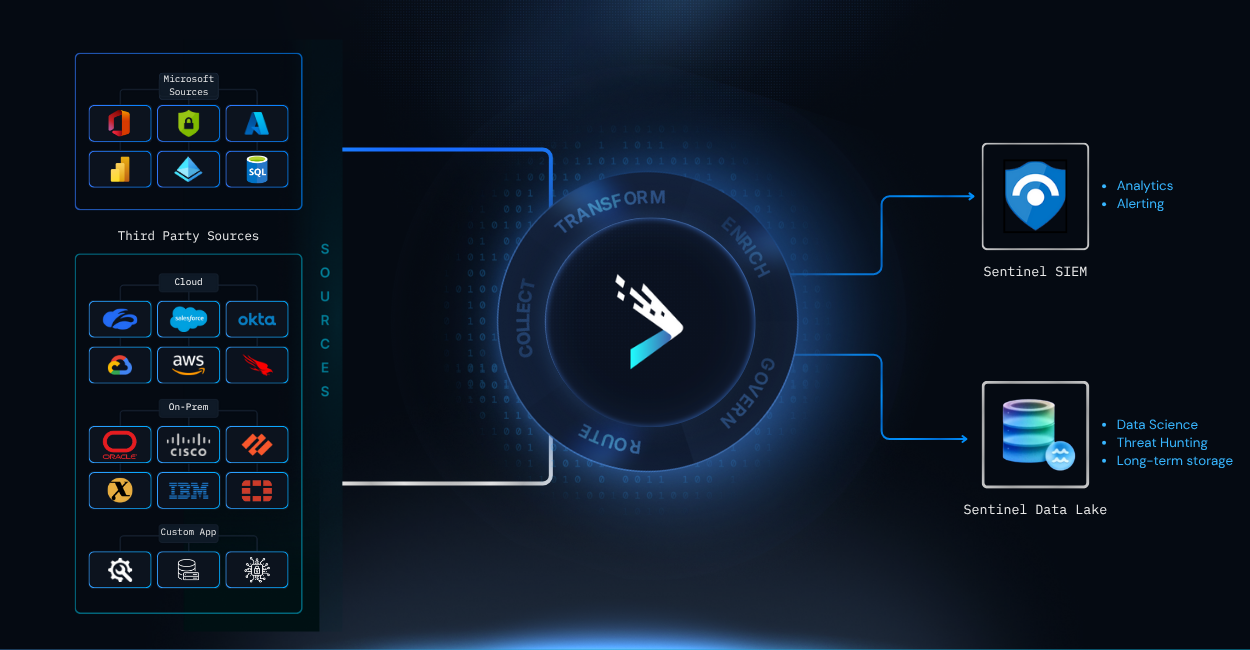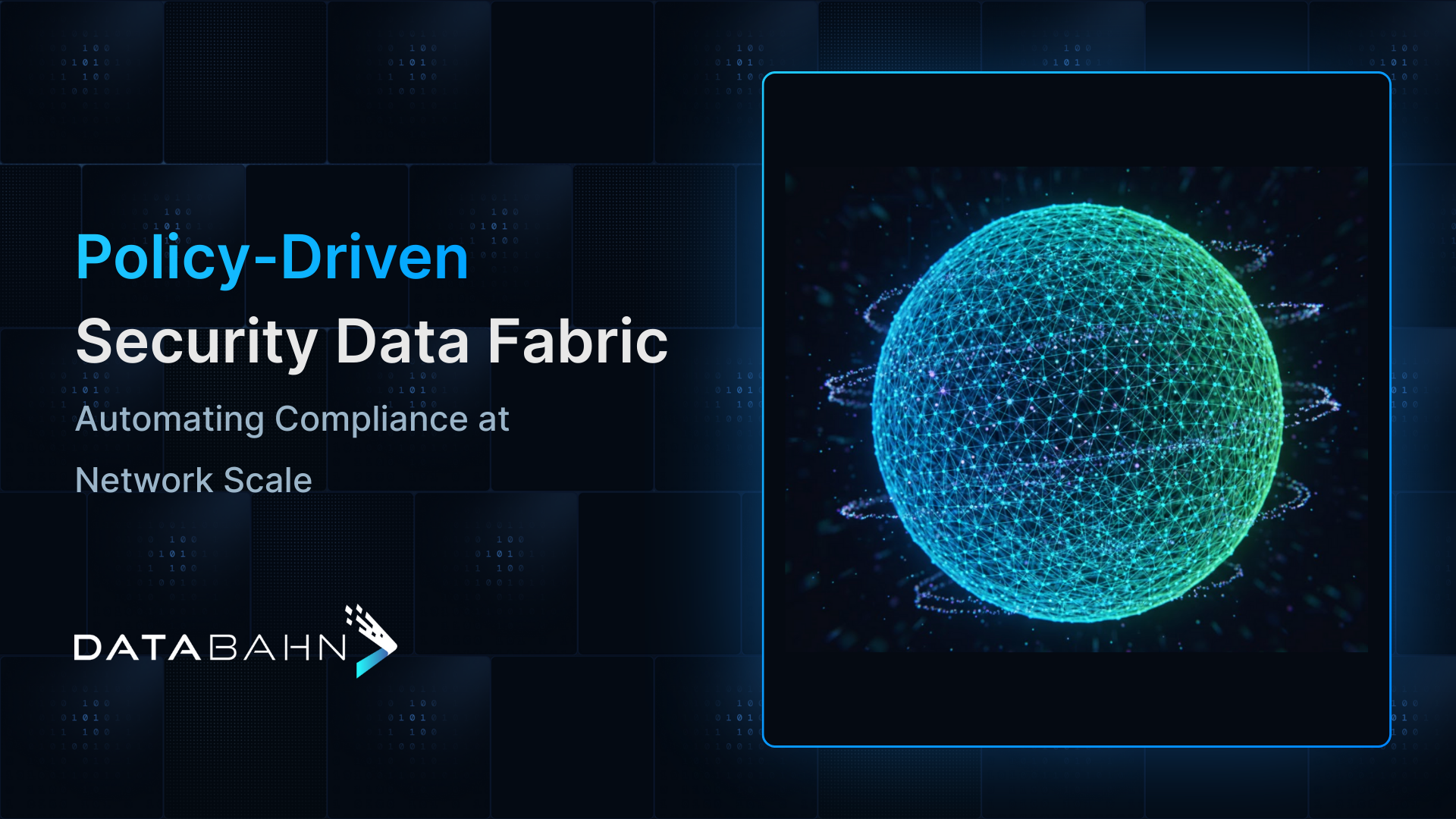Microsoft has recently opened access to Sentinel Data Lake, an addition to their extensive security product platform which augments analytics, extends data storage, and simplifies long-term querying of large amounts of security telemetry. The launch enhances Sentinel’s cloud-native SIEM capabilities with a dedicated, open-format data lake designed for scalability, compliance, and flexible analytics.
For CISOs and security architects, this is a significant development. It allows organizations to finally consolidate years of telemetry and threat data into a single location – without the storage compromises typically associated with log analytics. We have previously discussed how Security Data Lakes empower enterprises with control over their data, including the concept of a headless SIEM. With Databahn being the first security data pipeline to natively support Sentinel Data Lake, enterprises can now bridge their entire data network – Microsoft and non-Microsoft alike – into a single, governed ecosystem.
What is Sentinel Data Lake?
Sentinel Data Lake is Microsoft’s cloud-native, open-format security data repository designed to unify analytics, compliance, and long-term storage under one platform. It works alongside the Sentinel SIEM, providing a scalable data foundation.
- Data flows from Sentinel or directly from sources into the Data Lake, stored in open Parquet format.
- SOC teams can query the same data using KQL, notebooks, or AI/ML workloads – without duplicating it across systems
- Security operations gain access to months or even years of telemetry while simplifying analytics and ensuring data sovereignty.
In a modern SOC architecture, the Sentinel Data Lake becomes the cold and warm layer of the security data stack, while the Sentinel SIEM remains the hot, detection-focused layer delivering high-value analytics. Together, they deliver visibility, depth, and continuity across timeframes while shortening MTTD and MTTR by enabling SOCs to focus and review security-relevant data.
Why use Sentinel Data Lake?
For security and network leaders, Sentinel Data Lake directly answers three recurring pain points:
- Long-term Retention without penalty
Retain security telemetry for up to 12 years without the ingest or compute costs of Log Analytics tables
- Unified View across Timeframes and Teams
Analysts, threat hunters, and auditors can access historical data alongside real-time detections – all in a consistent schema
- Simplified, Scalable Analytics
With data in an open columnar format, teams can apply AI/ML models, Jupyter notebooks, or federated search without data duplication or export
- Open, Extendable Architecture
The lake is interoperable – not locked to Microsoft-only data sources – supporting direct query or promotion to analytics tiers
Sentinel Data Lake represents a meaningful evolution toward data ownership and flexibility in Microsoft’s security ecosystem and complements Microsoft’s full-stack approach to provide end-to-end support across the Azure and broader Microsoft ecosystem.
However, enterprises continue – and will continue – to leverage a variety of non-Microsoft sources such as SaaS and custom applications, IoT/OT sources, and transactional data. That’s where Databahn comes in.
Databahn + Sentinel Data Lake: Bridging the Divide
While Sentinel Data Lake provides the storage and analytical foundation, most enterprises still operate across diverse, non-Microsoft ecosystems – from network appliances and SaaS applications to industrial OT sensors and multi-cloud systems.
Databahn is the first vendor to deliver a pre-built, production-ready connector for Microsoft Sentinel Data Lake, enabling customers to:
- Ingest data from any source – Microsoft or otherwise – into Sentinel Data Lake
- Normalize, enrich, and tier logs before ingestion to streamline data movement so SOCs focus on security-relevant data
- Apply agentic AI automation to detect schema drift, monitor pipeline health, and optimize log routing in real-time
By integrating Databahn with Sentinel Data Lake, organizations can bridge the gap between Microsoft’s new data foundation and their existing hybrid telemetry networks – ensuring that every byte of security data, regardless of origin, is trusted, transformed, and ready to use.

Databahn + Sentinel: Better Together
The launch of Microsoft Sentinel Data Lake represents a major evolution in how enterprises manage security data, shifting from short-term log retention to a long-term, unified visibility-oriented window into data across timeframes. But while the data lake solves storage and analysis challenges, the real bottleneck still lies in how data enters the ecosystem.
Databahn is the missing connective tissue that turns Sentinel + Data Lake stack into a living, responsive data network – one that continuously ingests, transforms, and optimizes security telemetry from every layer of the enterprise.
Extending Telemetry Visibility Across the Enterprise
Most enterprise Sentinel customers operate hybrid or multi-cloud environments. They have:
- Azure workloads and Microsoft 365 logs
- AWS or GCP resources
- On-prem firewalls, OT networks, IoT devices
- Hundreds of SaaS applications and third-party security tools
- Custom applications and workflows
While Sentinel provides prebuilt connectors for many Microsoft sources – and many prominent third-party platforms – integrating non-native telemetry remains one of the biggest challenges. Databahn enables SOCs to overcome that hurdle with:
- 500+ pre-built integrations covering Microsoft and non-Microsoft sources;
- AI-powered parsing that automatically adapts to new or changing log formats – without manual regex or parser building or maintenance
- Smart Edge collectors that run on-prem or in private cloud environments to collect, compress, and securely route logs into Sentinel or the Data Lake
This means a Sentinel user can now ingest heterogeneous telemetry at scale with a small fraction of the data engineering effort and cost, and without needing to maintain custom connectors or one-off ingestion logic.
Ingestion Optimization: Making Storage Efficient & Actionable
The Sentinel Data Lake enables long-term retention – but at petabyte scale, logistics and control become critical. Databahn acts as an intelligent ingestion layer that ensures that only the right data lands in the right place.
With Databahn, organizations can:
- Orchestrate data based on relevance before ingestion: By ensuring that only analytics-relevant logs go to Sentinel, you reduce alert fatigue and enable faster response times for SOCs. Lower-value or long-term search/query data for compliance and investigations can be routed to the Sentinel Data Lake.
- Apply normalization and enrichment policies: Automating incoming data and logs with Advanced Security Information Model (ASIM) makes cross-source correlation seamless inside Sentinel and the Data Lake.
- Deduplicate redundant telemetry: Dropping redundant or duplicated logs across EDR, XDR, and identity can significantly reduce ingest volume and lower the effort of analyzing, storing, and navigating through large volumes of telemetry
By optimizing data before it enters Sentinel, Databahn not only reduces storage costs but also enhances the signal-to-noise ratio in downstream detections, making threat hunting and detection faster and easier.
Unified Governance, Visibility, and Policy Enforcement
As organizations scale their Sentinel environments, data governance becomes a major challenge: where is data coming from? Who has access to what? Are there regional data residency or other compliance rules being enforced?
Databahn provides governance at the collection and aggregation stage of logs to the left of Sentinel that benefits users and gives them more control. Through policy-based routing and tagging, security teams can:
- Enforce data localization and residency rules;
- Apply real-time redaction or tokenization of PII before ingestion;
- Maintain a complete lineage and audit trail of every data movement – source, parser, transform, and destination
All of this integrates seamlessly with Sentinel’s built-in auditing and Azure Policy framework, giving CISOs a unified governance model for data movement.
Autonomous Data Engineering and Self-healing Pipelines
Having visibility and access to all your security data becomes less relevant when there is missing data or gaps due to brittle pipelines or spikes in telemetry. Databahn’s agentic AI builds an automation layer that guarantees lossless data collection, continuously monitors data health, and fixes schema consistency and tracks telemetry health.
Within a Sentinel + Data Lake environment, this means:
- Automatic detection and repair of schema drift, ensuring data remains queryable in both Sentinel and Data Lake as source formats evolve.
- Adaptive pipeline routing – if the Sentinel ingestion endpoint throttles or the Data Lake job queue backs up, Databahn reroutes or buffers data automatically to prevent loss.
- AI-powered insights to update DCRs, to keep Sentinel’s ingestion logic aligned with real-world telemetry changes
This AI-powered orchestration turns the Sentinel + Data Lake environment from a static integration into a living, self-optimizing system that minimizes downtime and manual overhead.
With Sentinel Data Lake, Microsoft has reimagined how enterprises store and analyze their security data. With Databahn, that vision extends further – to every device, every log source, and every insight that drives your SOC.
Together, they deliver:
- Unified ingestion across Microsoft and non-Microsoft ecosystems
- Adaptive, AI-powered data routing and governance
- Massive cost reduction through pre-ingest optimization and tiered storage
- Operational resilience through self-healing pipelines and full observability
This partnership doesn’t just simplify data management — it redefines how modern SOCs manage, move, and make sense of security telemetry. Databahn delivers a ready-to-use integration with Sentinel Data Lake, enabling enterprises to connect Sentinel Data Lake to their existing Sentinel ecosystem, or plan their evaluation and migration to the new and enhanced Microsoft Security platform with Sentinel at its heart with ease.



.png)




.png)
.png)





.avif)

.avif)








